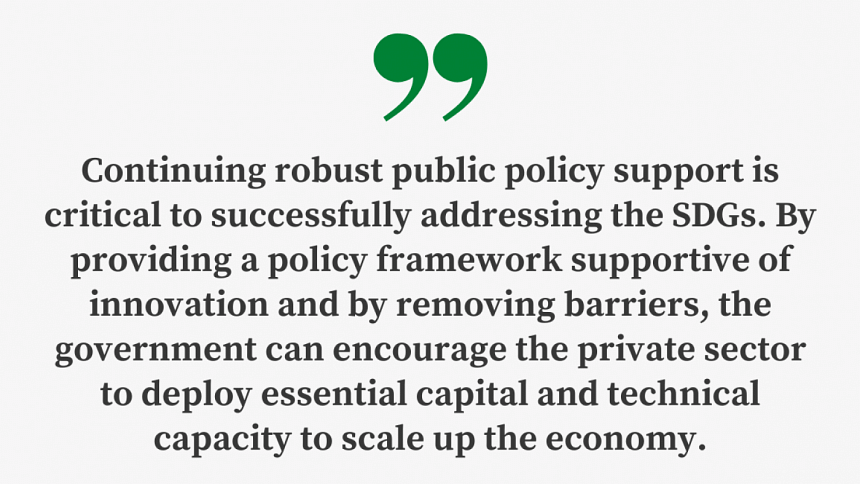We need ‘green’ private-sector climate risk financing

With the increasing frequency and impact of natural disasters around the world caused by climate change, the use of innovative climate and disaster risk financing tools has become ever more important to improve financial preparedness and build community resilience to imminent future disasters. For Bangladesh, a country highly vulnerable to climate risk, notably cyclones and floods, innovative climate financing must be envisaged to mitigate the risks associated with climate change.
According to a recent Intergovernmental Panel for Climate Change (IPCC) report (2022), roughly half of the world's population – especially in the communities of Africa, small islands, and coastal areas, central and South America, South Asia, and Artic regions – are already being affected by severe climate change, resulting in scarcity of food and water insecurity. The limited financial capacity of these regions places severe constraints on their ability to provide basic services and resources where they are needed most. The report further highlights that human mortality from natural disasters for the period 2010-2020 was 15 times higher in these vulnerable regions. The International Disaster Database (EM-DAT) also reported 12,386 climate-related disasters globally over the last century, with 20 million deaths and economic losses of USD 4.130 trillion, the brunt borne by the developing countries.
Securing financial assets to combat climate change is not easy, particularly for developing economies such as Bangladesh. While governments at various levels play a key role in mobilising public funding, they often fail to catalyse private capital flows to accelerate investment in climate resilient infrastructure. As a credible source of funds, climate experts are increasingly interested in leveraging private finance, calling for more effective government policies and tools to stimulate private investments, especially in quality infrastructure that has been found to have a positive impact on improving disaster resilience. However, large infrastructure projects often pose a variety of risks for the private sector, such as political regime change that may affect the viability of such projects through subsidy cuts, increased regulatory barriers, and withdrawal of tax incentives, to name a few. To unlock the potential of private sector investments, it is important to address the burden of risk by sharing it with the public sector.
This calls for a radical paradigm shift by designing effective financial instruments to upgrade and fortify environmental quality and strengthen public finance that also leverages private finance. For this to happen, systemic modifications, policy reforms, and institutional arrangements are crucial. Thus, various forms of private sector financing options need to be considered to achieve environmentally or socially sustainable outcomes, as well as the United Nations' Sustainable Development Goals (SDGs).

It is important to note that the private financial sector has significant resources and the potential to create economic wealth while meeting public interest needs for long-term sustainability and social wellbeing. Mobilisation of economic and corporate constituents takes place within certain boundaries and national and institutional structures in the system of financial regulations and corporate law. The European Union (EU) mainstreaming agenda in sustainable finance, for instance, aims for ambitious outcomes, resulting from the simultaneous reorientation of investors as well as their investee companies and the prioritisation of sustainable objectives. Private enterprises can optimise stakeholders' wealth, socio-environmental responsibility, and fulfilment of SDGs. The private sector has thus been set the challenge of responding positively in support of the SDGs while at the same time acting in the interests of its stakeholders. Thus, the private sector is both a potential partner and a key player, and can contribute to development objectives in multiple ways for the achievement of the SDGs, such as stimulating healthy habits and job creation, providing investment opportunities, and sharing the resources and knowledge required to shape innovative solutions to global climate challenges.
Continuing robust public policy support is critical to successfully addressing the SDGs. By providing a policy framework supportive of innovation and by removing barriers, the government can encourage the private sector to deploy essential capital and technical capacity to scale up the economy. Leveraging private sector finance provides a good initial indication of the strength of the sustainability-related market signals, and the adaptability and potential effectiveness of sustainability policies.
Policies that provide permanent and continuous incentives on an economy-wide basis exert stronger influence, as opposed to those which provide a temporary incentive or affect a limited segment of the economy. For example, a one-time grant to a specific firm favours that firm but does not provide an incentive for other actors within an industry. In contrast, a carbon tax applied economy-wide incentivises all firms to reduce emissions.
In the developing countries, private finance is only possible with an appropriate risk-adjusted return, with public support to overcome operational expenses and other obstacles, including climate-related research and development. Because the initial cost of adopting a low-carbon development path tends to be high, the necessity for early public intervention is vital.
Today, a wide variety of impediments hinder incentivising private sector engagement. Large up-front costs to invest in projects can be encouraged through incentives like transparent financial intermediation, stable political and regulatory bodies, and administrative simplicity. Ambiguous private-sector financial intermediation results in doubts about counterparty solvency and increased uncertainty about asset valuation. Due to the low-income level of people in developing countries, financial intermediation is often rudimentary or non-existent.
While green and climate finance is growing by leaps and bounds at the global level, the private sector in Bangladesh could benefit from accessing such global funds, particularly in the renewable energy sector. Such funds are often provided by the Global Energy Efficiency and Renewable Energy Fund (GEEREF), which seeks to use public finance to leverage private investment in renewable energy, guided by the European Investment Bank (EIB). Bangladesh is eligible to utilise such funds, but the private sector does not have much experience or expertise to access them, and so needs to develop the expertise to do so. Hence investment in building the capacity of the private finance sector, along with creating a supportive and enabling environment by the government, would enable Bangladesh to attract many tens of billions of US dollars over the next 5 to 10 years. This would enable private sector investment growth and allow Bangladesh to transition from the least developed country status which is likely to take place in the next few years. In turn, this will end the country's reliance on grant-based overseas development funds that it has been used to receiving for decades.
Tapan Sarker is professor and head of Finance Discipline at the School of Business, University of Southern Queensland, Australia. Saleemul Huq is director, International Centre for Climate Change and Development at the Independent University, Bangladesh. Syed Saad Andaleeb is distinguished professor emeritus at Pennsylvania State University, US.

 For all latest news, follow The Daily Star's Google News channel.
For all latest news, follow The Daily Star's Google News channel. 









Comments